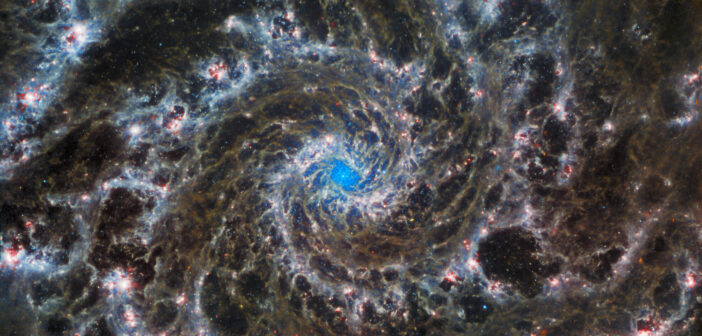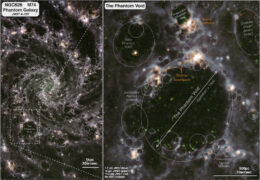The Physics at High Angular resolution in Nearby GalaxieS (PHANGS) program predates JWST, beginning with observations of carbon monoxide gas in 90 nearby spiral galaxies with the Atacama Large Millimeter/submillimeter Array (ALMA). Observations with the Hubble Space Telescope and the Very Large Telescope followed, diving deeper into a subset of these galaxies. Now, JWST has embarked on a new phase of the survey, aiming to perform 2–21 micron (1 micron = 10-6 meter) imaging of 19 galaxies in the PHANGS sample. The PHANGS–JWST First Results focus issue introduces JWST data of four galaxies, delving into the complex relationship between star formation, stellar feedback, and the conditions of the interstellar medium.
Janice Lee (NOIRLab and Steward Observatory) and collaborators introduced the survey, describing the 19 galaxies that JWST will observe by mid-2023. Importantly, all 19 of these galaxies have also been observed by Hubble, ALMA, and the Very Large Telescope, providing a broad multi-wavelength view of star formation in nearby galaxies. The four galaxies analyzed in the focus issue — NGC 7496, IC 5332, NGC 628, and NGC 1365 — were observed in summer 2022 using JWST’s Near Infrared Camera (NIRCam) and Mid-Infrared Instrument (MIRI). The articles published in the focus issue are introduced below, loosely grouped into four research themes.
Perspectives on Polycyclic Aromatic Hydrocarbons
Polycyclic aromatic hydrocarbons (PAHs) are organic molecules made up of multiple rings of carbon atoms. These sooty molecules are an important component of a galaxy’s interstellar medium; PAHs absorb the light from young stars and reprocess it, shining warmly in the infrared. About 20% of the infrared light we see from a star-forming galaxy comes from these molecules.
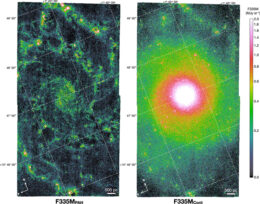
Maps of the galaxy NGC 628 showing the 3.3-micron emission due to PAHs (left) and stars (right). [Sandstrom et al. 2023]
Two research teams led by Jérémy Chastenet (Ghent University) also tackled aspects of PAH emission. In the first article, the team studied how the fraction of interstellar dust found in the form of PAHs changes with a variety of factors, including the abundance of metals (elements heavier than helium). In the second article, the team found that PAHs tend to be hotter and more ionized in the vicinity of HII regions — bubbles of glowing ionized hydrogen gas created by young stars.

Locations of star clusters (white circles) in three of the four galaxies in the sample. The background images are taken in JWST’s 7.7-micron filter. The scale bar is 1 kiloparsec/3,262 light-years. Click to enlarge. [Dale et al. 2023]
A collaboration led by Oleg Egorov (Heidelberg University) investigated how PAHs in star-forming regions might meet their demise. In their analysis of 1,529 HII regions across four galaxies, the team found that PAHs are likely destroyed by ultraviolet radiation from young stars.
Tracing Structures of Gas and Dust
Using JWST’s precision imaging, researchers can examine and interpret fine structures traced by gas and dust. David Thilker (Johns Hopkins University) and collaborators studied filamentary dust structures, creating maps that allowed them to compare structures seen in infrared PAH emission and those seen via scattering or absorption of visible photons.
Adam Leroy (Ohio State University) led two teams in using emission lines to trace gaseous structures. In one article, Leroy’s team compared JWST data to previous observations of the four galaxies in the sample made at optical and submillimeter wavelengths. The mid-infrared emission seen with JWST was well correlated with the optical (H-alpha) and submillimeter emission, suggesting that JWST can trace both the presence of dust and heating by stars. In the second article, the team explored correlations between the mid-infrared emission measured by JWST and submillimeter emission from carbon monoxide molecules. These correlations, many of which were remarkably intact across all of the galaxies studied, can be used to inform future studies of mid-infrared emissed seen by JWST.
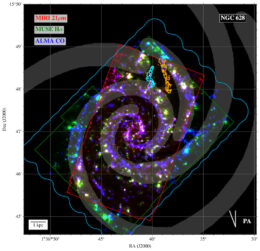
A three-color image of NGC 628 composed of 21-micron JWST imaging (red), H-alpha emission imaged by the Very Large Telescope (green), and carbon monoxide emission imaged by ALMA (blue). The two spurs are outlined in orange and cyan. [Williams et al. 2023]
A team led by Thomas Williams (University of Oxford; Max Planck Institute for Astronomy) focused on star formation in two spurs emerging from a spiral arm of NGC 628. This study showed that star formation does take place outside the galaxy’s spiral arms, within these two spurs, with similar star-formation efficiencies in each spur despite differences in the properties of the interstellar medium within them.
Pursuing Stellar Feedback
As young stars begin to form, they heat up their cold cradles and disrupt the surrounding gas with powerful winds. These processes, known as stellar feedback, impact the formation of future stars. JWST allows for precise tracing of dust and cool gas in star-forming galaxies, enabling a refined look at how stars forming today are impacted by previous generations of stars.
Ashley Barnes (University of Bonn and European Southern Observatory) and collaborators report on numerous “bubbles” or voids of low-density gas that appear to have been blown by newly forming stars in the galaxy NGC 628. The largest bubble appears to have been created not just by young stars — though the authors expect baby stars got the bubble started — but also by supernovae pushing the walls of the bubble outward with explosive force.Elizabeth Watkins (Heidelberg University) and coauthors analyzed NGC 628’s voids as well, amassing a catalog of 1,694 hand-selected bubbles ranging from 40 to 3,600 light-years in diameter. Analysis of the cataloged bubbles suggests that bubble mergers are common, and the presence of a bubble has important impacts on star formation down the line. In addition, elongation of bubbles along the curve of the galaxy’s spiral arms suggests that spiral arms play a defining role in star formation as well.
A team led by Jaeyeon Kim (Heidelberg University) tackled another aspect of the galaxy NGC 628: the earliest, most obscured phase of star formation. The team showed that young stars can remain embedded within their natal molecular cloud — and therefore hidden from the eyes of visible-light telescopes like Hubble — for 5 million years, which is about 20% the lifetime of a molecular cloud.
A Cluster of Star-Cluster Results

Hubble image of NGC 1365 showing the locations of previously known star clusters (yellow and white circles) and those newly discovered with JWST (red circles). Click to enlarge. [Whitmore et al. 2023]
Nils Hoyer (Donostia International Physics Center; Max Planck Institute for Astronomy; Heidelberg University) and collaborators tackled the nuclear star cluster at the heart of the spiral galaxy NGC 628. After determining the properties of the cluster, the team concluded that it likely hadn’t experienced much star formation over the past few billion years, though the reason for the cessation is unknown.
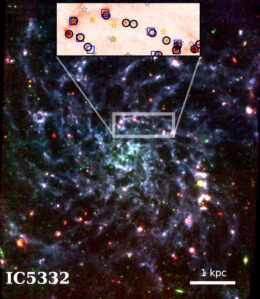
Three-color image of IC 5332, a spiral galaxy 30 million light-years away, with compact sources indicated by the different symbols in the zoomed-in region. Click to enlarge. [Adapted from Hassani et al. 2023]
Hamid Hassani (University of Alberta) scoured the 21-micron JWST data for signs of compact sources, which may indicate the presence of star clusters hidden within the dust. At such a long wavelength, even JWST isn’t capable of resolving individual star clusters, so Hassani’s team found a way to use the sources’ colors to classify them as interstellar medium sources, dusty stars, or background galaxies.
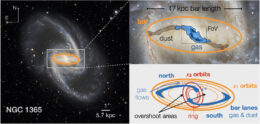
Optical image of NGC 1365 from the Dark Energy Survey (left) and schematics illustrating the structures within the central galactic bar (right). Click to enlarge. [Schinnerer et al. 2023]
Eva Schinnerer (Max Planck Institute for Astronomy) and collaborators also investigated the center of NGC 1365, pairing the new JWST images with archival ALMA data to probe the conditions within the galaxy’s central bar. This study revealed streams of gas within the bars, the convergence of which sets the stage for star formation.
Citation
The full list of research articles in the PHANGS–JWST First Results focus issue can be found here. Individual articles are linked to in the text above.

